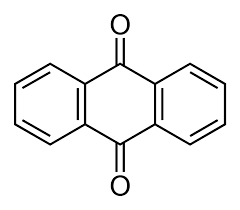The Naturopathic Herbalist
Anthraquinones are the main active constituents in herbs often used to relieve constipation. They have an irritant or stimulating laxative effect on the large intestine. They constitute the largest group of naphthaquinones, and are often red or purple in pigment. They are widely distributed in plants, especially in the Fabaceae, Liliaceae, Polygonaceae, and Rhamnaceae families.

Anthraquinone Structure
Anthraquinones are commonly found as glycosides in the living plant, and several groups are distinguished based on the degree of oxidation of the nucleus and whether one or two unites make up the core of the molecule. The anthrones and less oxygenated than the anthraquinones and the dianthrones are formed from two anthrone units. Studies using dianthrone glycosides such as sennosides A and B suggest most of these compounds pass through the upper GI tract without any change, however they are subsequently metabolized in the colon by the natural flora (mainly bacteria) of the GI tract. Note: need healthy bacterial flora for maximum effects!
Anthraquinone rich herbs are most indicated for flaccid or atonic constipation that is characterized by a loss of bowel tone and thus an infrequency of bowel movements. It is usually caused by a lack of exercise, prolonged best rest or habitual laxative use, and is more common in elderly populations.
Pharmacology (How they Work)
Anthraquinones act directly on the intestinal mucosa, influencing several pharmacological targets, and their laxative effect is largely due to increased peristalsis of the colon, reducing transit time and consequently the reabsorption of water from the colon making the stool more liquid and easing bowel movements. Additionally the stimulation of active chloride secretion into the gut increase osmosis, and results in a subsequent increased excretion of water. Overall the result is an increase in fecal volume and GI pressure.
Their action is very much dose dependent. In lower doses, anthraquinones exert a milder tonic laxative effect. In larger doses they will have a more powerful stimulant to cathartic effect.
In summary their major pharmacological actions are as follows:
- Stimulation of active transport of chloride into the gut lumen → osmotic pull in the gut → accumulation of fluid in gut
- Inhibition of Na-K ATP-ase activity of the enterocytes → inhibition of water, sodium and chloride reabsorption, and an increase in enteric secretion of potassium
- Stimulation of localized, inflammatory prostaglandins → increased force and rate of peristalsis
Toxicity Concerns & Contraindications
At high doses anthraquinone-rich herbs are gastrointestinal irritants, causing toxicity symptoms that can include nausea, vomiting, bloody diarrhea, dermatitis, dizziness, acute abdominal pain & cramping, and in severe cases, kidney damage. In general the following are important considerations with their usage:
- Use caution in irritable bowel, bowel obstructions, spastic colon, acute intestinal inflammation, abdominal pain of unknown origin, children <12 years old
- A harmless reddish discolouration of urine and feces may occur
- Use for short-term only. Use > 10 days exacerbates atonicity of the colon and can lead to dependence on laxatives for a bowel movement to occur
- Recurrent use or abuse can lead to electrolyte imbalances (particularly hypokalemia), dehydration, and muscle and kidney damage
- Dramatic decrease in transit time can interfere with absorption of medications
- Can provoke reflex contractions in the uterus when taken during pregnancy, leading to miscarriage
- Should be avoided in those with gout or a predisposition to kidney stones
In addition, Long-term dosing can cause:
- Peroxidation of lipids in the enteric mucosa → lipo-fuscin residue and brownish pigmentation called melanosis, which may be a risk factor bowel cancer
Herbal examples:
- Aloe barbadensis (Aloe)
- Cassia sp. (Senna)
- Rheum palmatum (Turkey Rhubarb)
- Rhamnus frangula/purshiana (Cascara sagrada)
- Rumex crispus (Yellow Dock)
Note: Among anthraquinone-containing laxatives, the gentlest acting compounds belong to Yellow Dock (Rumex crispus) and Rhubarb (Rheum palmatum). These herbs are aged for at least one year, during which the more irritant anthraquinones are converted to milder compounds. The presence of tannins in these plants also tends to moderate the laxative effect.

Comments are closed.